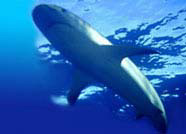


Jaws and teeth

 |
 |
 |
|||
| Home | Evolution
| Classification
| Glossary | Biology
| Behavior | Shark
Repellent | Shark
Conservation | Do's &
Don'ts | Did You Know?
Jaws and teeth |
 |
||||
|
 Cut
the Jaws and teeth of the Shark and you have lost it. The "business"
end of the Shark is its head with powerful Jaws and row upon row of formidable
teeth- what they are famous for and recognized with. The mouth of most
sharks is situated at the underside of the head and can be thrust forward
while catching a prey. For instance, a lemon shark is an active hunter
capable of rapid acceleration. When approaching the target with speed,
it brakes with its pectoral fins, raises its snout, drops its lower jaw
and teeth and then jabs forwards several times to get a good grip. The
protruding upper jaw retracts under the head, pulling the prey into the
mouth. It then rips and tears the flesh of its victim by shaking its head
from side to side. Cut
the Jaws and teeth of the Shark and you have lost it. The "business"
end of the Shark is its head with powerful Jaws and row upon row of formidable
teeth- what they are famous for and recognized with. The mouth of most
sharks is situated at the underside of the head and can be thrust forward
while catching a prey. For instance, a lemon shark is an active hunter
capable of rapid acceleration. When approaching the target with speed,
it brakes with its pectoral fins, raises its snout, drops its lower jaw
and teeth and then jabs forwards several times to get a good grip. The
protruding upper jaw retracts under the head, pulling the prey into the
mouth. It then rips and tears the flesh of its victim by shaking its head
from side to side.
 The
size of tooth may vary from shark to shark depending on their lifestyle
and need. To grab a slippery fish or squid, some sharks like Shortfin
Mako and Sandtiger shark have got sharp pointed teeth. The tiger shark
has serrated teeth, resembling those in a chain saw to slice through flesh
and bone, and even the tough carapaces of sea turtles. The
size of tooth may vary from shark to shark depending on their lifestyle
and need. To grab a slippery fish or squid, some sharks like Shortfin
Mako and Sandtiger shark have got sharp pointed teeth. The tiger shark
has serrated teeth, resembling those in a chain saw to slice through flesh
and bone, and even the tough carapaces of sea turtles.The great white shark's teeth change with the age. When young, this formidable predator has pointed teeth for grabbing fish, but on maturing, it develops triangular, saw-like teeth in the upper jaw for carving through the flesh of sea mammals, and awl-like, grasping teeth in the lower jaw for holding its prey steady--rather like the knife-and-fork combination. Sharks loose their teeth at a great rate. For example, a lemon shark looses a row of her teeth every eight days. But this is not a problem for sharks. It is a part of an excellent system of tooth replacement nature has provided them with. The teeth are borne on a 'conveyor belt' arrangement, with newly developing teeth at the back and the full-grown teeth at the front. The new ones move forward when the old ones are damaged, blunted or drop out and in this way are replaced endlessly throughout life.  Shark
skin Shark
skin Sharks are highly efficient swimmers. The streamlined shortfin mako has been seen to leave the water at speeds estimated to be in excess of 75 km/hour (46mph). It achieves this remarkable feat partly with a hydrodynamic body shape and powerful swimming muscles, but also with the help of its skin. Shark skin is covered with tiny 'teeth' (dermal denticles) and each species has denticles of a different shape. They are the shark's secret weapons. You can feel the denticles if you stroke a shark. If you move your hand from front to back it feels smooth, but if you brush the other way the skin feels like a carpenter's rasp. These 'skin teeth' protrude from the skin and are aligned in such a way that they channel the water across the shark's body in the most efficient way. The  y
also work in the interface between skin and water, reducing drag and allowing
the sharkto 'slide' through the sea. y
also work in the interface between skin and water, reducing drag and allowing
the sharkto 'slide' through the sea. In experiments during the 1980s at Scripps Institution of Oceanography, California, the efficiency of a blue shark was compared to that of a submarine and, weight for weight, the shark required six times less driving power. This discovery has led designers of racing yachts, submarines, aircraft and even bathing suits to experiment with 'rough' rather than 'smooth' surfaces for their products. The results in terms of energy saving have been remarkable. |
|
|||||||||||
| Sitemap | Reach To Us | Jimtrade - Business Directory of India | ||||||||||||